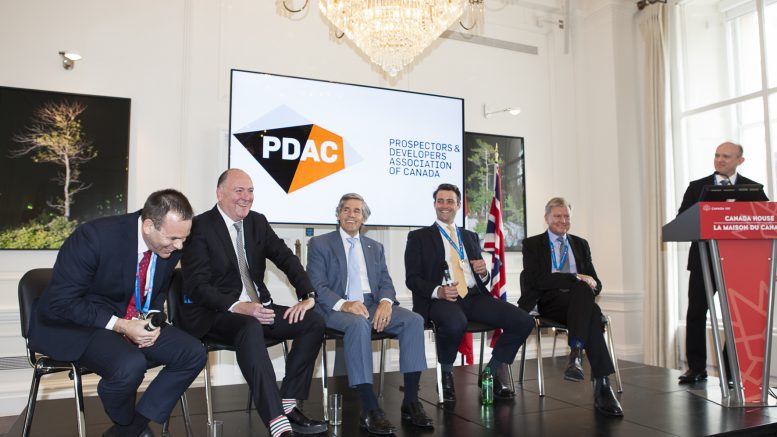This week we’re digging deep into capital allocation courtesy of our all-star panel discussion from the Canadian Mining Symposium in London, U.K., in May. Discussion ranges from mergers and acquisitions to dividend policy, and beyond!
The panel members include: Stephen R. Mullowney, managing director & partner, Consulting & Deals, PwC; Patrick Anderson, president and CEO, Dalradian Resources; Rob McEwen, executive chairman, McEwen Mining; Ed Sterck, director, BMO Capital Markets; Ian Pearce, chairman, New Gold; and moderator John Cumming, editor-in-chief, The Northern Miner.
Meanwhile, Lesley discusses x-ray fluorescence technology (XRF) in reference to Barrick Gold‘s (TSX: ABX; NYSE: ABX) ongoing sociopolitical issues in Tanzania (a popular topic this week). The Canadian major holds a 63.9% equity interest in Acacia Mining (LON: ACA), which is the largest gold producer in the African country with three operating mines, namely: Bulyanhulu, Buzwagi and North Mara. Barrick has been negotiating with the Tanzanian government over a halt on concentrate exports that President John Magufuli instituted on March 3.
Subscribe, rate and follow us on SoundCloud, iTunes, YouTube, Google Play, Stitcher or RSS Feed!
Timeline:
2:42 Touch of macro ft. copper, gold, and met coal
6:31 Panel discussion of TNM/PwC report — ‘Strategies for excess cash’
7:05 The Geology Corner ft. Acacia Mining and XRF technology
Sponsored by:


Articles referenced:
Barrick, Acacia at odds with gov’t in Tanzania
Video: Panel discussion of TNM/PwC report — ‘Strategies for excess cash’
Video: Lifetime Achievement Award and fireside chat with Robert Friedland
GT Gold surges on greenfield discovery in BC’s Golden Triangle
PDAC 2017: Copper, zinc looking good for 2017
Music Credits:
Energy Recorded by Bensound (www.bensound.com/royalty-free-music/track/energy)
Licensed under Creative Commons: By Attribution-NoDerivs 3.0 Unported
creativecommons.org/licenses/by-nd/3.0
Isolated Kevin MacLeod (incompetech.com)
Licensed under Creative Commons: By Attribution 3.0 License
creativecommons.org/licenses/by/3.0/
Beach Bum Kevin MacLeod (incompetech.com)
Licensed under Creative Commons: By Attribution 3.0 License
creativecommons.org/licenses/by/3.0/







The podcast dealing with Tanzania/Acacia and XRF is spot on. As a pathfinder instrument it is great and if you have 20oz/ton it will show good bands under 50kev.
Will note that besides As, W causes a huge band overlap. In the right hands, it’s a nice tool. 100% scientific then 100% interpretation. Dealers often sell the equipment as a shoot and click….ain’t so.
While I recognize that there is a bigger issue in the story at play, for anyone interesed, I would like to make a few general comments only toward the portable XRF. First of all, that is a very valid comment Robert and that is unfortunate that some are sold by those at a low knowledge level for the application they are selling into. I have witnessed this myself. Though I suppose the same can be said from everything from impostering consulting geochemists to other equipment and software on the market. It is the world or the economy we live in unfortunately. Aside from this, I would like to comment that there are several different calibrationes, configurations and recommended practices (from manufacturers, CAMIRO and other parts of the internet to provide sufficient education on use). While we might speculate on an XRF in general as in this case – potable XRF certainly cannot be referred to in general, blanket statements as there is great variance on the market. The XRF is sold as an analytical tool and the users and those responsible for the project where it is used need to keep that in mind; ownership of any analytical instrument comes with some responsibility (understanding how to use the instrument and QC, for example). Nearly every conference I attend has a talk, a course or an expert on site, not to mention a large user Group with success stories and advice. It is difficult to avoid the Information. Additionally where there is mention of a difference of a factor of 10, I offer the idea that users sometimes make errors in calculations between the reported % and ppm which is a factor of 10000 (some mistakingly use 1000 or similar). Finally, if we could put an ICP-MS in a portable form and let untrained users opérate we might have some similar stories. I just like to level the playing Field and to offer my experience. Thank you for the article and podcast and our ability to comment. I look forward to following the story.
May I add to my comment that, while it is yet to be confirmed that any of this is the case in this situation, I would like to add that my comments certainly do not mean to imply negligence. Rather in my 7 years involved with the instrumentación, these are some of the common misunderstandings on the market. In addition to the podcast and link offered, this is a share of experience with other potable XRF users.